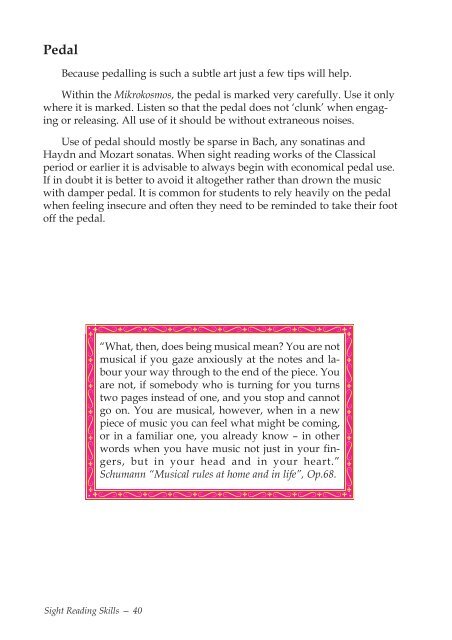Sight Reading Skills - Anthony Maydwell - AnthonyMaydwell.com
Sight Reading Skills - Anthony Maydwell - AnthonyMaydwell.com
Sight Reading Skills - Anthony Maydwell - AnthonyMaydwell.com
Create successful ePaper yourself
Turn your PDF publications into a flip-book with our unique Google optimized e-Paper software.
Pedal<br />
Because pedalling is such a subtle art just a few tips will help.<br />
Within the Mikrokosmos, the pedal is marked very carefully. Use it only<br />
where it is marked. Listen so that the pedal does not ‘clunk’ when engaging<br />
or releasing. All use of it should be without extraneous noises.<br />
Use of pedal should mostly be sparse in Bach, any sonatinas and<br />
Haydn and Mozart sonatas. When sight reading works of the Classical<br />
period or earlier it is advisable to always begin with economical pedal use.<br />
If in doubt it is better to avoid it altogether rather than drown the music<br />
with damper pedal. It is <strong>com</strong>mon for students to rely heavily on the pedal<br />
when feeling insecure and often they need to be reminded to take their foot<br />
off the pedal.<br />
<strong>Sight</strong> <strong>Reading</strong> <strong>Skills</strong> — 40<br />
“What, then, does being musical mean? You are not<br />
musical if you gaze anxiously at the notes and labour<br />
your way through to the end of the piece. You<br />
are not, if somebody who is turning for you turns<br />
two pages instead of one, and you stop and cannot<br />
go on. You are musical, however, when in a new<br />
piece of music you can feel what might be <strong>com</strong>ing,<br />
or in a familiar one, you already know – in other<br />
words when you have music not just in your fingers,<br />
but in your head and in your heart.”<br />
Schumann “Musical rules at home and in life”, Op.68.


